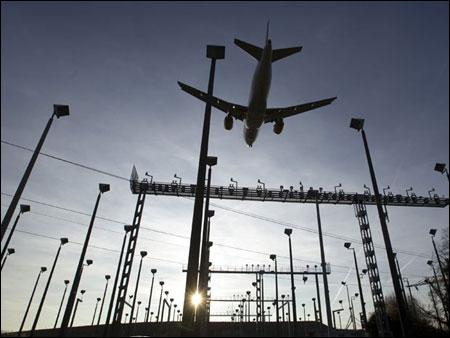Photographs: Denis Balibouse/Reuters Disha Kanwar in New Delhi
The civil aviation ministry has decided to scrap the existing rule that makes it mandatory for domestic airlines to deploy 10 per cent of capacity on non-viable routes like the Northeast, Jammu & Kashmir and Andaman & Nicobar Islands.
Instead, the airlines willing to fly to routes considered non-viable would be given subsidy under the Essential Air Services Fund floated recently. This would be funded partly by the central government's Budgetary support and partly by imposing a cess on passengers flying between the country's metros. Also, state governments would be asked to underwrite some seats on these routes to support domestic carriers.
The list for non-viable routes (Category 2), apart from the current locations, would be extended and re-categorised to include other regional connections that do not make good money at present.
The changes planned would be incorporated in a new regional connectivity policy, expected to be announced within a month.
A senior civil aviation ministry official said there had been a lot of anomalies in airlines trying to comply with the present route dispersal guidelines that mandated flying 10 per cent of capacity (available seat km) to non-viable sectors like the Northeast.
"Airlines tend to fly bigger planes to commercially viable destinations within the Northeast, such as Guwahati and Dibrugarh, to adhere to the 10 per cent requirement. And, connectivity to other remote areas continues to suffer. So, we have decided to scrap the rule and come out with a new alternative where they would get subsidy."
At present, Air India is the only domestic carrier that flies 17-18 per cent of its capacity to commercially non-viable routes.
The ministry official said the change might not lead to rise in fares to metro cities; it would only make the process more transparent. "Currently also, the airlines cross-subsidise non-viable routes via travellers on the metro route but the amount a traveller has to pay is unknown. With the new system, he will know what he is paying. So, we do not expect fares to rise with the levy of this cess," the ministry official added.
The revamped policy of regional air connectivity will also include concessions for carriers flying to Tier-III and -IV cities on air traffic control charges. Currently the Airports Authority of India does not charge any landing or parking charges from planes with 80 or less seats. It has been incurring losses of more than Rs 100 crore (Rs 1 billion) on Northeast airports.
Besides, state governments would be asked to reduce sales tax on aviation turbine fuel (ATF) to attract private carriers to fly to their airports. The sales tax on ATF, at around 24 per cent, is among the steepest in the world - next only to Bangladesh's 27 per cent.
Some experts, however, say passing the buck to states to increase connectivity to non-profitable airports may not be practical.



article